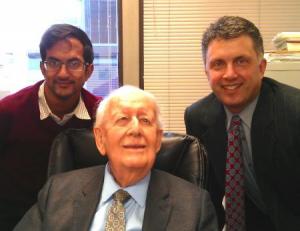From Counter-Narrative to New Multi-Track Diplomacy
From Counter-Narrative to New Multi-Track Diplomacy
 Names like “John Burton,” “Joseph Montville,” “Harold Saunders,” and “John W. McDonald” will probably ring a bell if you are associated with George Mason University’s School for Conflict Analysis and Resolution (S-CAR). These are some of the founders of the field of Track II diplomacy, i.e., non-governmental, informal and unofficial dealmaking between actors of different States regarding matters of public concern. In the early 1990s, the term “Multi-Track Diplomacy” was coined by Louise Diamond and Ambassador (ret.) John McDonald to describe a systems-based approach to peacemaking and peacebuilding that goes beyond two tracks, to nine.
Names like “John Burton,” “Joseph Montville,” “Harold Saunders,” and “John W. McDonald” will probably ring a bell if you are associated with George Mason University’s School for Conflict Analysis and Resolution (S-CAR). These are some of the founders of the field of Track II diplomacy, i.e., non-governmental, informal and unofficial dealmaking between actors of different States regarding matters of public concern. In the early 1990s, the term “Multi-Track Diplomacy” was coined by Louise Diamond and Ambassador (ret.) John McDonald to describe a systems-based approach to peacemaking and peacebuilding that goes beyond two tracks, to nine.
Ambassador McDonald, the founder of the Institute for Multi-Track Diplomacy (IMTD), serves on S-CAR’s Advisory Board and was a U.S. State Department and United Nations diplomat for 40 years before becoming a peace activist. He began as a district attorney for the Allies in 1947 Berlin and is now 93 years old. Yet he continues to work five days a week and Multi-Track Diplomacy is more salient today than ever. The work of some S-CAR faculty and others hints at why building Multi-Track Diplomacy into what I call “New Multi-Track Diplomacy” (NMTD) matters and why we at IMTD hope S-CAR will think and talk about it as a community. I briefly describe some associated scholarship below and suggest how it might move the concept of New Multi-Track Diplomacy forward.
In Soft Power, Joseph Nye, former Dean of the Kennedy School of Government at Harvard University, famously explained the power of attraction and legitimacy in foreign relations. Describing the world as a ‘three-dimensional chess game,’ he outlined why and how, in the 21st century multipolar world, with its transnational challenges and links, legitimacy is connected to narratives. As Nye has stated, ‘national narratives are, indeed a type of currency’ and, as the Financial Times wrote in endorsing Nye’s The Future of Power, “the best military can lose to the adversary with the better story.”
Yet, S-CAR Professor Sara Cobb, Director of the Center for the Study of Narrative and Conflict Resolution, highlighted the destructive nature of counter-narrative in Speaking of Violence, the Politics and Poetics of Narrative in Conflict Resolution. Narrative feedback loops can spiral actors downwards, reducing complexity and often leading to ‘states of exception’ that do violence to both their creators and the objects of their attempts to control.
S-CAR Associate Professor Susan H. Allen has built her Problem Solving Workshop practice and conflict mitigation work partially on these bodies of knowledge. In so doing, she has advanced best practices and the evidence base in the field of Multi-Track Diplomacy beyond what its founders could have envisioned (see for example, Theories of Change in Indicator Development in Conflict Management and Mitigation, USAID, 2010). One component of her Conflict Management and Mitigation work includes something we would describe as akin to “therapeutic diplomacy,” i.e., helping parties come to terms with the past and heal.
The foreign policy aim to heal the Other at that same time as we protect ourselves is at the root of Shaun Riordan’s “Dialogue-based Public Diplomacy: A New Foreign Policy Paradigm?” in Jan Melissen’s The New Public Diplomacy. Riordan highlights the essence of genuine dialogue – accepting the value of other traditions without sacrificing one’s own integrity. In a similar way as Riordan emphasized, the credibility of New Multi-Track Diplomacy is enhanced by some degree of independence from Western Governments. Thus, there is an increasing role for non-state actors in U.S. diplomacy.
Healing relationships is at the heart of S-CAR’s philosophy of conflict resolution and NMTD as well. Healing goes beyond Nye’s instrumentalist use of ‘attractive power.’ Healing does not exclude Hard Power. Facilitating healing is a matter of both soft and hard, just as military power is.
U.S. allied non-state actors helping countries to heal has much more potential for U.S. diplomacy than State-sponsored violent coercion alone does in a multi-polar world full of transnational, diffuse problems. One thing that is new at IMTD is that we are learning how to operationalize healing through country assessment by facilitating Inclusive Nationalism. Our primary tool is a macro, strengths-based “therapy” of sorts, in the form of “Inclusive Nationalism Country Assessment” or “INCA” (see our partner’s website, sovereigntyfirst.com). We facilitate national understandings of power/alliance and generate national development on a large number of indices. We can measure incremental progress in which, a la Lederach’s (2004) call for imagination, we help foster an optimistic yet realistic vision of the future. Through such thinking and in such a way, we are transforming Multi-Track Diplomacy into New Multi-Track Diplomacy. The U.S. can leverage New Multi-Track Diplomacy by sculpting a future with partners in a common destiny rather than allowing ourselves to be thrown off balance through overly-broad use of violent coercion.




